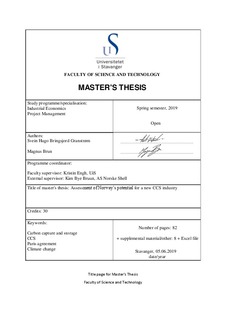| dc.contributor.advisor | Engh, Kristin | |
| dc.contributor.advisor | Bye Bruun, Kim | |
| dc.contributor.advisor | Bruun, Kim Bye | |
| dc.contributor.author | Brun, Magnus | |
| dc.contributor.author | Granstrøm, Svein Hugo Bringsjord | |
| dc.coverage.spatial | Norway | nb_NO |
| dc.date.accessioned | 2019-11-11T10:30:24Z | |
| dc.date.available | 2019-11-11T10:30:24Z | |
| dc.date.issued | 2019-06-05 | |
| dc.identifier.uri | http://hdl.handle.net/11250/2627655 | |
| dc.description | Master's thesis in Industrial economics | nb_NO |
| dc.description.abstract | This thesis will investigate whether Norway has a potential for a carbon capture and storage (CCS) industry. Norway has committed to the Paris agreement, and to reduce their non-ETS emissions by 40% from 2005 levels by 2030. The Intergovernmental Panel on Climate Change revealed that if the climate goals in the Paris agreement shall be met, CCS will play an important role and represents a solution in three out of four possible pathways for reaching the desired target. Currently, CCS deployment is slow and only 18 CCS facilities are operating today worldwide. The Global CCS institute argues that we need to capture 3.75 Gtpa by year 2040 to achieve the climate targets in the Paris agreement.
Norway has shown great interest for CCS, where it has been used at offshore platforms for decades. With the CCS test centre at Mongstad and the planned full-scale CCS facility from Norcem Brevik and Fortum Oslo, Norway can take a pioneering role and encourage global CCS deployment. This thesis will investigate how well suited the external framework around CCS is in Norway, and if the technology can offer a new important industry in Norway. The research was divided into two parts; a PESTEL analysis to highlight drivers and barriers for CCS deployment, and a mapping of CO2-emitting sources in Scandinavia to reveal if there is a market for CO2 storage in terms of access to industrial CO2 emissions and available storage capacity.
The findings show that Norway is well positioned for large scale CCS deployment, particularly due to well-assessed storage capacity, sub-surface knowledge and experience, and public and private interest in investing in development of CCS projects. The mapping of CO2 sources indicates that there is a potential for a big market in Scandinavia, with large emitting sources accessible by ship. However, the research also revealed that there are many barriers. The EU Directive for CCS is currently creating financial and reliability barriers that discourage operators and investors from investing in CO2 storage. The technology has proven very costly, resulting in deficient political backing and incentives. Based on the above, it is concluded that Norway has great potential for CCS to become a new industry, but certain aspects would need to be solved before Norway can offer an environment in which CCS can thrive. | nb_NO |
| dc.language.iso | eng | nb_NO |
| dc.publisher | University of Stavanger, Norway | nb_NO |
| dc.relation.ispartofseries | Masteroppgave/UIS-TN-ISØP/2019; | |
| dc.rights | Navngivelse 4.0 Internasjonal | * |
| dc.rights.uri | http://creativecommons.org/licenses/by/4.0/deed.no | * |
| dc.subject | industriell økonomi | nb_NO |
| dc.subject | industrial economics | nb_NO |
| dc.subject | klimaendringer | nb_NO |
| dc.subject | carbon capture | nb_NO |
| dc.subject | karbonfangst og -lagring | nb_NO |
| dc.title | Assessment of Norway's potential for a new CCS industry | nb_NO |
| dc.type | Master thesis | nb_NO |
| dc.subject.nsi | VDP::Technology: 500 | nb_NO |
| dc.subject.nsi | VDP::Social science: 200::Economics: 210 | nb_NO |

